I have a problem that, after much head scratching, I think is to do with very small numbers in a long-double.
I am trying to implement Planck's law equation to generate a normalised blackbody curve at 1nm intervals between a given wavelength range and for a given temperature. Ultimately this will be a function accepting inputs, for now it is main() with the variables fixed and outputting by printf().
I see examples in matlab and python, and they are implementing the same equation as me in a similar loop with no trouble at all.
This is the equation:
My code generates an incorrect blackbody curve:

I have tested key parts of the code independently. After trying to test the equation by breaking it into blocks in excel I noticed that it does result in very small numbers and I wonder if my implementation of large numbers could be causing the issue? Does anyone have any insight into using C to implement equations? This a new area to me and I have found the maths much harder to implement and debug than normal code.
#include <stdio.h>
#include <math.h>
#include <stdlib.h>
//global variables
const double H = 6.626070040e-34; //Planck's constant (Joule-seconds)
const double C = 299800000; //Speed of light in vacume (meters per second)
const double K = 1.3806488e-23; //Boltzmann's constant (Joules per Kelvin)
const double nm_to_m = 1e-6; //conversion between nm and m
const int interval = 1; //wavelength interval to caculate at (nm)
//typedef structure to hold results
typedef struct {
int *wavelength;
long double *radiance;
long double *normalised;
} results;
int main() {
int min = 100 , max = 3000; //wavelength bounds to caculate between, later to be swaped to function inputs
double temprature = 200; //temprature in kelvin, later to be swaped to function input
double new_valu, old_valu = 0;
static results SPD_data, *SPD; //setup a static results structure and a pointer to point to it
SPD = &SPD_data;
SPD->wavelength = malloc(sizeof(int) * (max - min)); //allocate memory based on wavelength bounds
SPD->radiance = malloc(sizeof(long double) * (max - min));
SPD->normalised = malloc(sizeof(long double) * (max - min));
for (int i = 0; i <= (max - min); i++) {
//Fill wavelength vector
SPD->wavelength[i] = min + (interval * i);
//Computes radiance for every wavelength of blackbody of given temprature
SPD->radiance[i] = ((2 * H * pow(C, 2)) / (pow((SPD->wavelength[i] / nm_to_m), 5))) * (1 / (exp((H * C) / ((SPD->wavelength[i] / nm_to_m) * K * temprature))-1));
//Copy SPD->radiance to SPD->normalised
SPD->normalised[i] = SPD->radiance[i];
//Find largest value
if (i <= 0) {
old_valu = SPD->normalised[0];
} else if (i > 0){
new_valu = SPD->normalised[i];
if (new_valu > old_valu) {
old_valu = new_valu;
}
}
}
//for debug perposes
printf("wavelength(nm) radiance(Watts per steradian per meter squared) normalised radiance\n");
for (int i = 0; i <= (max - min); i++) {
//Normalise SPD
SPD->normalised[i] = SPD->normalised[i] / old_valu;
//for debug perposes
printf("%d %Le %Lf\n", SPD->wavelength[i], SPD->radiance[i], SPD->normalised[i]);
}
return 0; //later to be swaped to 'return SPD';
}
/*********************UPDATE Friday 24th Mar 2017 23:42*************************/
Thank you for the suggestions so far, lots of useful pointers especially understanding the way numbers are stored in C (IEEE 754) but I don't think that is the issue here as it only applies to significant digits. I implemented most of the suggestions but still no progress on the problem. I suspect Alexander in the comments is probably right, changing the units and order of operations is likely what I need to do to make the equation work like the matlab or python examples, but my knowledge of maths is not good enough to do this. I broke the equation down into chunks to take a closer look at what it was doing.
//global variables
const double H = 6.6260700e-34; //Planck's constant (Joule-seconds) 6.626070040e-34
const double C = 299792458; //Speed of light in vacume (meters per second)
const double K = 1.3806488e-23; //Boltzmann's constant (Joules per Kelvin) 1.3806488e-23
const double nm_to_m = 1e-9; //conversion between nm and m
const int interval = 1; //wavelength interval to caculate at (nm)
const int min = 100, max = 3000; //max and min wavelengths to caculate between (nm)
const double temprature = 200; //temprature (K)
//typedef structure to hold results
typedef struct {
int *wavelength;
long double *radiance;
long double *normalised;
} results;
//main program
int main()
{
//setup a static results structure and a pointer to point to it
static results SPD_data, *SPD;
SPD = &SPD_data;
//allocate memory based on wavelength bounds
SPD->wavelength = malloc(sizeof(int) * (max - min));
SPD->radiance = malloc(sizeof(long double) * (max - min));
SPD->normalised = malloc(sizeof(long double) * (max - min));
//break equasion into visible parts for debuging
long double aa, bb, cc, dd, ee, ff, gg, hh, ii, jj, kk, ll, mm, nn, oo;
for (int i = 0; i < (max - min); i++) {
//Computes radiance at every wavelength interval for blackbody of given temprature
SPD->wavelength[i] = min + (interval * i);
aa = 2 * H;
bb = pow(C, 2);
cc = aa * bb;
dd = pow((SPD->wavelength[i] / nm_to_m), 5);
ee = cc / dd;
ff = 1;
gg = H * C;
hh = SPD->wavelength[i] / nm_to_m;
ii = K * temprature;
jj = hh * ii;
kk = gg / jj;
ll = exp(kk);
mm = ll - 1;
nn = ff / mm;
oo = ee * nn;
SPD->radiance[i] = oo;
}
//for debug perposes
printf("wavelength(nm) | radiance(Watts per steradian per meter squared)\n");
for (int i = 0; i < (max - min); i++) {
printf("%d %Le\n", SPD->wavelength[i], SPD->radiance[i]);
}
return 0;
}
Equation variable values during runtime in xcode:


